| dc.contributor.author | Kvalvik, Liv Grimstvedt | en_US |
| dc.date.accessioned | 2018-05-28T07:45:01Z | |
| dc.date.available | 2018-05-28T07:45:01Z | |
| dc.date.issued | 2018-04-27 | |
| dc.identifier.isbn | 978-82-308-3794-8 | en_US |
| dc.identifier.uri | https://hdl.handle.net/1956/17723 | |
| dc.description.abstract | Background: Although a decline in smoking prevalence is seen in most developed countries, smoking during pregnancy remains an important public health concern, affecting both the mothers’ own health as well as that of her unborn child. Objectives: The objective was to study several aspects of smoking habits among pregnant women in Norway since 1999. Firstly, to assess changes and secular trends in smoking habits during pregnancy in the period 1999-2004. Secondly, to biochemically assess the validity of self-reported smoking habits in the Norwegian Mother and Child Cohort Study (MoBa). The third objective was to explore if women born with low birth weight more often end up as smokers as adults compared to women born with higher birth weight. The fourth aim was to assess the risk of small for gestational age (SGA) in 2nd pregnancy according to smoking habits in two successive pregnancies. Methods: Main data sources included The Medical Birth Registry of Norway with links to other registries (paper I: 1999-2004, paper III: 1967-2014 and paper IV: 1999-2014) and the MoBa (paper II: 2002-2003). Cross sectional files as well as generational and sibling files were used to pursue the objectives. Results: The overall daily smoking prevalence among Norwegian pregnant women decreased from 18% in 1999 to 11% in 2004 (Relative Risk (RR) 0.61, 95% Confidence Interval (CI) 0.58, 0.64)). The decline was observed in all subgroups. Maternal educational level was strongly associated with smoking at the end of pregnancy. More women quit smoking during pregnancy in the second half of the study period, compared to the first. Among a subsample of 2 997 women in MoBa an overall mean sensitivity of 81.9% (95% CI 77.3, 86.4) and specificity of 99.4% (95% CI 99.1, 99.7) was calculated for self-reported smoking habits with plasma cotinine concentrations as the gold standard. For the association between birth weight and later smoking habits we found that women born at term with low birth weight (<2000 grams) more often smoked at the end of their pregnancies compared with women born with higher birth weights (4 000-4 499 grams) (RR 1.8 (95% CI 1.4, 2.2)). We observed a similar trend between men’s birth weight and their partners’ smoking habits in pregnancy (RR 1.5 (95% CI 1.2, 2.0)). Daily smokers throughout the first pregnancy, who abstained throughout their second pregnancy, had a 1.3 increased risk of SGA in the second pregnancy (95% CI 1.1, 1.6), compared to persistent non-smokers. About two-fold risks were found for women who smoked daily throughout their first pregnancy, but had quit by the end of the second pregnancy (RR 2.0 (95% CI 1.6, 2.4)) and for women who were nonsmokers in the first pregnancy and daily smokers in their second (RR 1.8 (95% CI 1.4, 2.3)). Persistent smokers through both pregnancies had a 2.9 fold increased risk (95% CI 2.7, 3.1). Persistent smoking women who did not experience SGA in their first pregnancy, had a 2.7 fold increased risk of SGA in the 2nd pregnancy (95% CI 2.5, 3.0). Conclusions and implications: Smoking during pregnancy declined during 1999- 2004 in all subgroups, and maternal educational level was a strong indicator for smoking at the end of pregnancy. Self-reported smoking is a valid indicator of intrauterine exposure to tobacco smoke among participants in MoBa. Being born with low birth weight is associated with smoking in adulthood. This suggests a shared smoking environment through generations, and may account for some of the established association between birth weight and cardiovascular disease. Smoking information from both the beginning and the end of a pregnancy is important for adequate risk assessment of SGA in 2nd pregnancy. Persistently smoking women throughout two successive pregnancies had the highest risk of SGA in 2nd pregnancy. Women who smoked throughout both pregnancies with no previous SGA were not protected against SGA in the 2nd pregnancy. | en_US |
| dc.language.iso | eng | eng |
| dc.publisher | The University of Bergen | eng |
| dc.relation.haspart | Paper I: Kvalvik LG, Skjærven R, Haug K. Smoking during pregnancy from 1999 to 2004: a study from the Medical Birth Registry of Norway. Acta Obstetricia et Gynecologica Scandinavica 2008; 87: 280-5. The article is available in the main thesis. The article is also available at: <a href="https://doi.org/10.1080/00016340701837801" target="blank">https://doi.org/10.1080/00016340701837801</a> | en_US |
| dc.relation.haspart | Paper II: Kvalvik LG, Nilsen RM, Skjærven R, Vollset SE, Midttun O, Ueland PM, Haug K. Self-reported smoking status and plasma cotinine concentrations among pregnant women in the Norwegian Mother and Child Cohort Study. Pediatric Research 2012; 72: 101-7. Full text not available in BORA due to publisher restrictions. The article is available at: <a href="http://dx.doi.org/10.1038/pr.2012.36" target="blank">http://dx.doi.org/10.1038/pr.2012.36</a> | en_US |
| dc.relation.haspart | Paper III: Kvalvik LG, Skjærven R, Klungsøyr K, Vollset SE, Haug K. Can early programming be partly explained by smoking? Results from a prospective, population based cohort study. Paediatric and Perinatal Epidemiology 2015; 29: 50-9. The article is available at: <a href="http://hdl.handle.net/1956/10186" target="blank">http://hdl.handle.net/1956/10186</a>. | en_US |
| dc.relation.haspart | Paper IV: Kvalvik LG, Haug K, Klungsøyr K, Morken NH, DeRoo L, Skjærven R. Maternal Smoking Status in Successive Pregnancies and Risk of Having a Small for Gestational Age Infant. Paediatric Perinatal Epidemiology 2017; 31: 21-8. The article is available in the main thesis. The article is also available at: <a href="https://doi.org/10.1111/ppe.12333" target="blank">https://doi.org/10.1111/ppe.12333</a> | en_US |
| dc.title | Smoking among pregnant women in Norway. Prevalence, self-report validity, and associations to SGA and “early programming” using family and sibling design | en_US |
| dc.type | Doctoral thesis | |
| dc.rights.holder | Copyright the Author. All rights reserved | |
| dc.identifier.cristin | 1580519 | |
